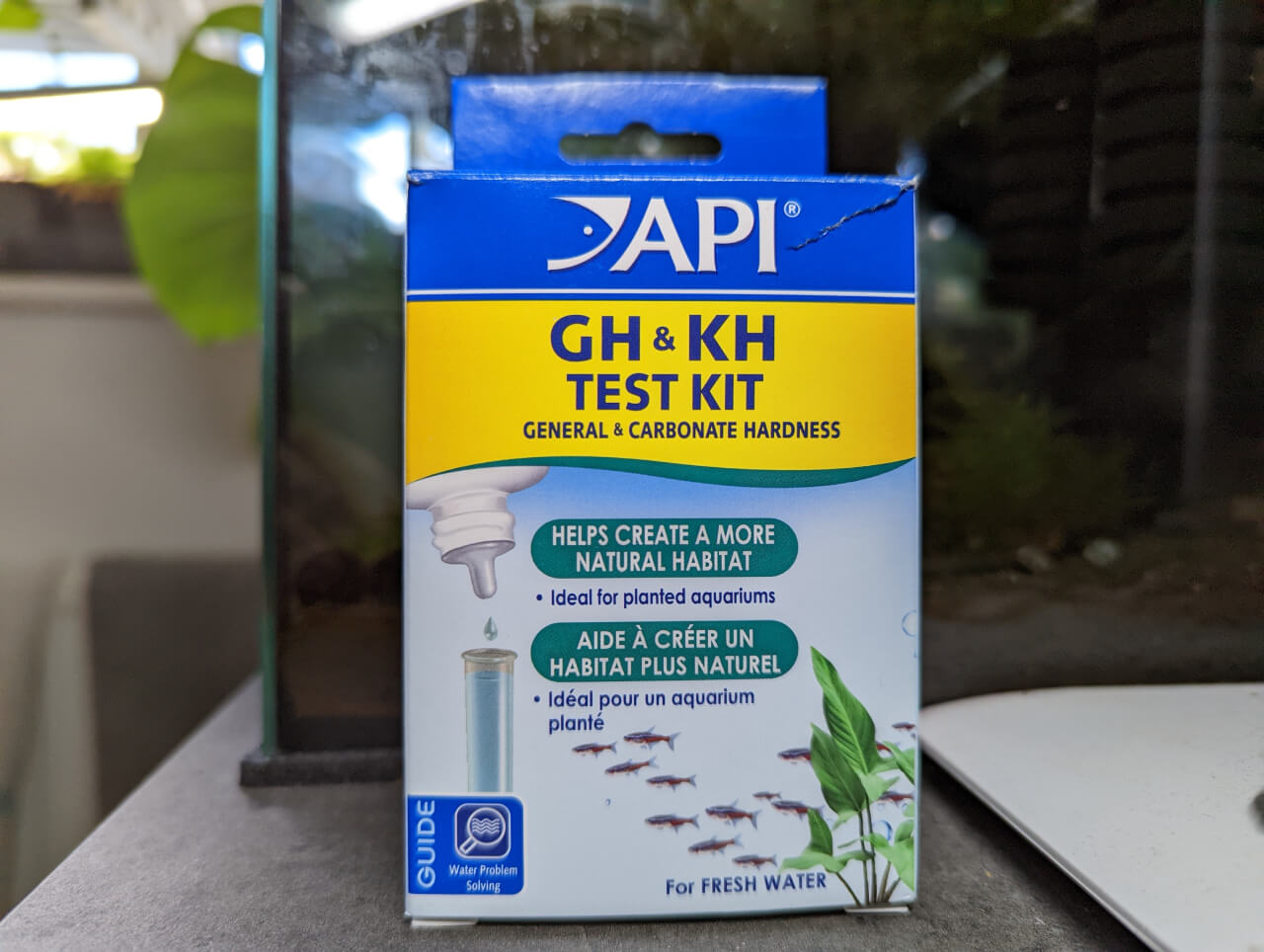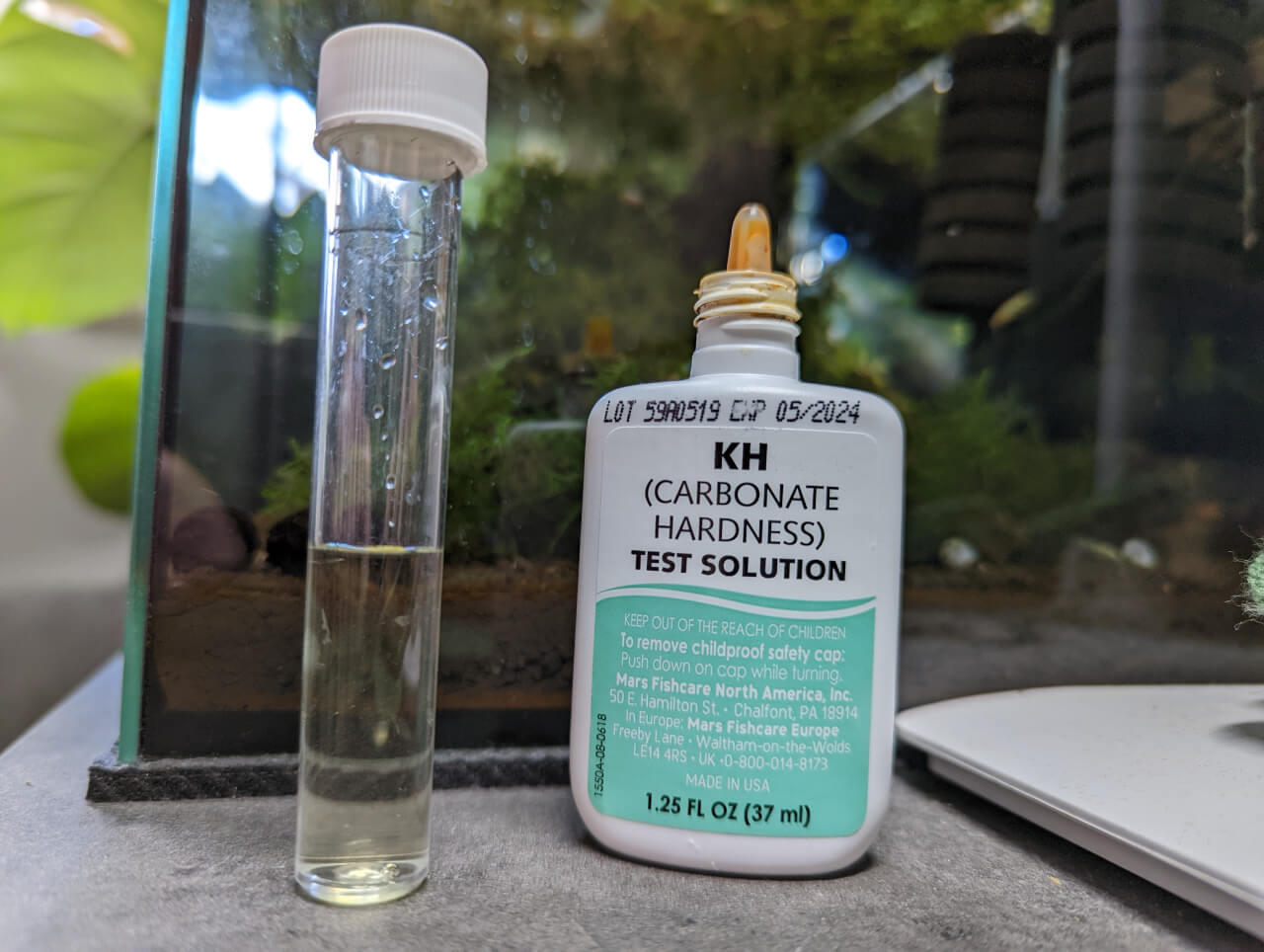Carbonate Hardness (KH) measures how many carbonates and bicarbonates are dissolved in your aquarium’s water.
A very simplified summary of what you’ll learn from this article is:
- As your water’s KH increases, so does its pH level
- Higher KH levels will keep the pH more stable and resistant to swings
This is explained in much more detail below, but it’s helpful to have a rough idea of what we’re talking about.
It’s a fairly common question to ask why we use the letter K in KH. The answer is simply because it stems from the German translation: Karbonathärte.
The carbonate hardness is one of two hardness parameters we measure in our shrimp tanks. General hardness (GH) is the other type, and they both have different effects on your water.
In order to properly explain what the carbonate hardness does and why it’s important to measure in your shrimp tank, we’ll first need to cover a bit of chemistry - specifically, pH levels.
What is pH?
PH, or Potential of Hydrogen, is another very important water parameter to monitor in your tank. It has a range of 0 - 14 (acid - alkali) and measures the amount of free hydrogen ions in a liquid.
A hydrogen ion is simply a molecule that has a positive charge and is extremely reactive.
Curiously, the pH scale is inverse to the number of ions. This means that water with a lot of free hydrogen ions has a low pH, whereas water with very few free ions has a high pH.
The scale is also logarithmic, meaning you need to increase the number of free hydrogen ions by 10 in order to raise the pH by 1.
For example, a pH of 6 is 10 times more acidic than 7 pH, and a pH of 6 is then 100 times more acidic than 8 pH, etc.
Buffer capacity
Now that we’ve covered the basics of pH, we can talk about something called buffer capacity.
The buffer capacity of a liquid measures how resistant it will be to changes in pH.
A liquid with a tiny buffer capacity will experience pH swings when even small amounts of other acid/alkali elements are added. On the other hand, a liquid with a high buffer capacity will take a lot more acid/alkali before its pH changes.
How KH affects pH
The KH measurement refers to the buffering capacity of the water.
Water with a high KH will keep a stable pH longer, whereas low KH will result in bigger pH swings.
Buffering with KH works by calcium carbonate reacting with the free hydrogen ions, consuming them in the process. The reduced number of free hydrogen ions then means the pH has increased.
To summarize: as the KH buffering capacity of the water increases, so does its pH level.
Why KH is important to shrimp
Carbonate hardness is important for shrimp for a few reasons, and the desired values vary between the different species.
- Neocaridina shrimp are best suited to water with a KH between 1 and 8
- Caridina shrimp should ideally be kept with KH levels between 0 and 1
For Neocaridina shrimp specifically, the calcium carbonate is useful for the molting process, it helps them to build a strong new shell. Too much KH can cause molt failures, such as if their current exoskeleton is too hard to break out of and often results in death.
As Neos also prefer living in water with a slightly alkaline pH (above 7), the KH will provide this for them.
In a planted tank, during the day, the plants will pull carbon dioxide out of the water and convert it to oxygen via photosynthesis. When carbon dioxide from the air dissolves into the water, it creates carbonic acid, and lowers the pH.
During the daytime, this photosynthesis causes the pH to increase as the carbonic acid is consumed by the plants. At night, the opposite occurs and the pH lowers as more CO2 dissolves back into the water.
These pH swings can be quite large, and could cause stress and shock for the shrimp. With a higher KH value, these swings would be much smaller and more manageable for the shrimp.
However, Caridina shrimp, like Blue Bolts for example, thrive in acidic water, so we can’t just add carbonates into their tank. This is where a special type of substrate known as buffering substrate comes in.
Buffering substrate
A buffering substrate is specifically made to stabilize the pH of your water, essentially replacing the need for carbonates and bicarbonates (KH).
This setup will allow you to maintain a consistent range of water parameters whilst keeping it acidic. Without a buffering substrate, Caridina shrimp kept at their preferred 0 KH would be subject to wild swings in pH throughout the day.
These substrates usually have a lifetime of 1-2 years before they’re much less effective and buffering the water. This obviously then means, for best results, you’ll need to basically rebuild your shrimp tank every 2 years to replace it.
Using remineralized water with a minimal KH value is highly recommended with these substrates. The substrate will also absorb the carbonates from the water and use up its buffering ability faster, and need replacing sooner.
How to measure KH
Measuring for KH is super simple with the right test kit.

It’s measured in units of dKH (degrees of carbonate hardness) and sometimes as ppm (parts per million). 1 dKH is equal to about 18ppm, or 17.8ppm to be precise.
These instructions are specifically for API’s freshwater KH test kit:
- Add 5ml of water into the test vial
- Hold the test tube bottle upside down over the vial and squeeze 1 drop at a time
- After each drop, cap the test vial and invert a few times to mix the liquid
- Stop adding drops when the water changes from blue to yellow
Make sure you hold the test liquid bottle vertically (completely upside down) so that the drops are all the same size. If you tilt the bottle instead, you might trap air bubbles and cause the drops to be different sizes, which will give you an inaccurate result.
The number of drops required to change the water colour gives you the dKH.
For example, if your water changes colour after 2 drops of the KH test fluid, your water measures 2 dKH or about 36ppm.
KH too high
Remember that shrimp prefer stability and consistency instead of hitting some specific number target with your water parameters. Don’t panic just because your KH is slightly higher than the recommended value.
You should only try to reduce the carbonate hardness if you notice any issues outlined below, or your KH is a lot higher than the recommended range for your species.
Symptoms
The symptoms below don’t mean that a high KH is the single reason for problems, but can be helpful to troubleshoot issues.
- PH swinging a lot throughout the day
- Measure the tank’s pH first thing in the morning and again at the end of the day, and compare these two values
How to reduce KH
Try any of these options to attempt reducing your KH level. Choose one at a time and slowly watch for any changes or signs of trouble.
- Perform water changes with remineralized water at desired parameters
- Use Seachem Acid Buffer
- Add hardscape or foods that will introduce tannins to your water, these will also lower your pH:
- Indian almond leaves
- Alder cones
- Driftwood / Bogwood
KH too low
Both Caridina and Neocaridina shrimp will be absolutely fine living with a KH of 1, so don’t rush to increase your KH to meet some specific number.
Only make changes to your water’s make-up if you notice symptoms of problems caused by low KH.
Symptoms
These symptoms could be caused by other issues with the tank, but can often be associated with a high KH level.
- Failed molts: calcium carbonate is used to build their shell
How to increase KH
Try any one of the options below to try and increase your KH. Choose only one at a time and carefully monitor for any unexpected changes or behaviour.
- Perform water changes with remineralized water at a higher KH
- Use Seachem Alkaline Buffer
- Add limestone or other hardscape rocks containing calcium, e.g. Seiryu stone
- Add crushed coral to your tank

